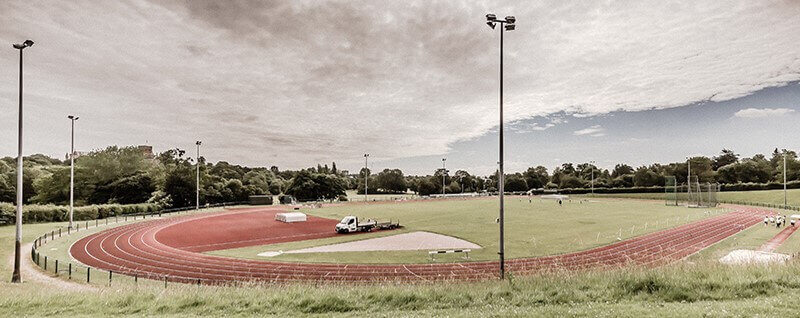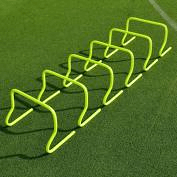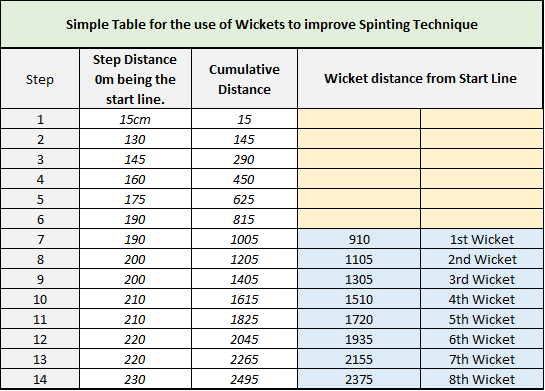The first and most important question you should ask and answer! Is what am I using the “Wickets drill” for?
Before I get “wickets” anywhere near athletes they need to be able to the basics correctly!
The switch! A crucial element of the stride cycle that is cascade to all the mechanical elements of true sprinting speed.
For so many years I have seen and heard coaches and athletes talk about how they can improve their stride length and then they subsequently place ‘markers’ at ridiculous spacing’s causing the athletes to greatly over stride and throw out their entire technical timings.
There are two crucial and easy technique cue points that coaches need to look for in sprint technique in my opinion, and they are pointed out crucially by Ralph Mann. And if like me you’re sad enough to have read his book you will be aware of these two markers.
And funnily enough they both involve the Recovery Leg / Swing leg.
- The rotational position of the heal (high carry stepping up and over the stance leg)
- The recovery position at stance (the position of the swing knee when the stance leg is directly underneath the body)(optimal, is for the swing leg to have broken the vertical plane of the stance leg as early as possible whilst not sacrificing the stride cycle)
There are of course many other areas to review and improve upon in order to fully reach sprint technique and top speed nirvana, but these two will take you a long way! And hopefully ahead of everyone else in the race!
I like to amalgamate the above in to a little analogy when I get new athletes down or to reinforce the imagery for existing athletes.
“Driving a car with a flat tyre, means the rubber is on the floor for longer and you will never get any speed. Running with a lower heal carry and over striding is the same.
You want a nice full tyre and flowing arc for the heal carry to get full speed.”
And so, the answer to the question! The Wickets drill is not about stride length, it is about cueing the athlete to get into front side mechanics, a stepping over action with a quick switch of the legs
The first drill I start any athlete or session with is a simple ‘hop over’, I use the term Hop even though there is a change in leg I want the athlete to be thinking about the pop required to change the leg and get over the hurdle. A definitive dual action is required, a powerful ‘stomp’ of the coming stance leg (must be an affirmative action, I use the phrase, pop the balloon, imagine a balloon that has to be popped (I have used actual balloons in 1-2-1 sessions where required) The swing leg must attempt to get into the ‘flamingo’ pose ASAP (High knee and High Heal) This is the exercise that aids in the improvement in that swing phase timings.
We can then of course move onto using wickets, and no matter spacing or size hurdles you use, the switch must be visible at all times whilst going over the hurdles.
So, on to Wickets!
A simple way to work out your spacing is to start with a uniformed distance, I like to use an incremental increase of 15cm. starting at first foot contact over the start line being 15cm and I want my 1st wicket to be the 7th Step.
The 7th step for a good sprinter will be somewhere around and 10m line and it is at this point you have already reached 70% of your maximum speed and your body position will be approaching upright (hip Hight) so this is where we will begin the cueing of good step over sprint mechanics. (stride length increases diminish with upright mechanics, but if you hold a forward lean for too long you will never reach the stride length potential)
Athletes should aim to hit each marker during the build up and over the first hurdle. Each marking should be hit with a backward action of the landing leg ideally contact being made directly under the Hips (even in this accelerating position). If athletes are casting out over the tape, acceleration is done, Once the ball of the foot begins to land in front of the hip towards the knee during acceleration, Its Over! Mechanics will suffer and you will have to change to a more forced technique.
Coaching point is to observe this and Make sure athletes don’t make this error during the first six steps in the acceleration of the drill.
For most good club level athletes the distance between the first set of wickets will be 190cm, use this setting to space out the first six steps using cones, discs, or tape. If the drill is performed ideally, the athlete will land in the middle between wickets 1 and 2. Using this mark, count back 190cm toward the start to mark the 6th acceleration step. each remaining step to the beginning will be reduced by 15cm. Using these as a guide you can easily adjust the distance depending on athlete ability, gender, size etc. usually by 10cm either way.
Therefore, having a distance of 190cm for the first set of hurdles, the acceleration steps would have the following marks: 1 (first contact over the line) 15cm, 2=130cm, 3=145cm, 4=160cm, 5=175cm, 6=190, followed by the first wicket placed 95cm after the sixth acceleration step to begin the spacing for the remainder of the wickets.
I like to use wickets/hurdles of at least 6 inches and somewhat higher after the first 2 steps to ensure the athlete has a visual cue to lift and step over!
We will continue expanding the distances at a rate of every 3rd step by 10cm from this point on (15cm for advanced athletes)but will only continue for 8 hurdles (only when advanced extend to 12 and beyond), after this point the athletes are to maintain the technical model and run in the “fly” to keep the acceleration runs to 30m
Key Points!
- Only use wickets when basic switch drills are mastered
- Wickets are for technique improvement not stride length improvement (stride length comes from improved technique not by forcing)
- Acceleration observations are to ensure the foot strike is under the hips in the early steps.
- In the stance position the Swing thigh must be ahead of the vertical line.
- You can extend the spacing only when the athletes are able to fully and correctly switch between the wickets (use slow motion cameras for reference)
- Wicket/hurdle Height is fully dependent on the athletes ability to switch




